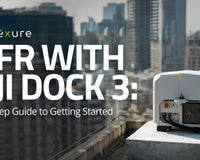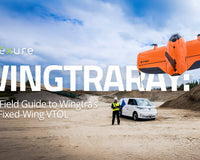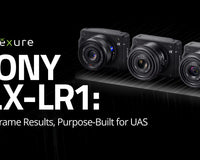A drone pilot stands at the edge of a construction project site just after sunrise, the air still heavy with dust from the previous day. The plan is simple on paper: collect control points, verify elevations, and get the drone in the air before the wind picks up.
However in practice, it never's never quite that simple. They've lost time before, fumbling with Bluetooth pairings, waiting for a fix to stabilize, or re-entering NTRIP credentials after a dropped correction.
For professionals in construction, surveying, and GIS, time in the field is precious. It is the measure of how well every project stays on schedule. Teams need equipment that works as quickly as they do, hardware that connects instantly, maintains signal, and stays stable when every other variable in the day is unpredictable.
That is the design philosophy behind Emlid's Reach RX2. Built on the same plug-and-play workflow that made the original RX popular, it brings new hardware muscle to the field: a 672-channel GNSS engine for stronger reception, IMU-based tilt compensation to cut leveling time, and a ruggedized build meant to keep working when the network, the weather, or the terrain does not cooperate.
In the sections ahead, we will examine how the new RX2 refines the RX platform, what those changes mean in real-world mapping and layout, and how RX2 might fit into your workflows.
Emlid Reach RX2 at a Glance

Built for the same workflows that made the original Reach RX popular, the RX2 strengthens every key system: its GNSS engine, power efficiency, and field durability, while maintaining the lightweight, portable design that professionals have come to rely on.
Below is a quick reference comparison of the two receivers and their key technical specifications:
| Feature | Reach RX | Reach RX2 |
|---|---|---|
| RTK Precision | H: 7 mm + 1 ppm V: 14 mm + 1 ppm |
H: 7 mm + 1 ppm V: 14 mm + 1 ppm |
| Tilt Compensation | Not supported | RTK + 2 mm + 0.3 mm/° |
| GNSS Support | GPS, GLONASS, Galileo, BeiDou | All-band GNSS (GPS, GLONASS, Galileo, BeiDou, QZSS, NavIC) |
| Channels | 184 | 672 |
| Battery Life | Up to 16 hrs (5200 mAh) | Up to 16 hrs (7000 mAh, faster charging) |
| Weight | 250 g | 280 g |
| Mount | 5/8”-11 UNC | 5/8”-11 UNC + quick release |
| Ingress Rating | IP68 (1.5 m water, 30 min) | IP68 (1.5 m water, 30 min) |
| Connectivity | Bluetooth 4.2, USB-C | Bluetooth 4.2, USB-C |
| Certifications | FCC, CE, IC, Apple MFi* | FCC, CE, IC, Apple MFi |
| Special Features | None | All-band RTK (L1/L2/L5/L6), L-band corrections (<10 cm global), quick-release |
Tilt Compensation

Tilt compensation is one of the most significant workflow upgrades in the RX2. Unlike the original RX, which required a vertical pole to maintain centimeter-level precision, the RX2 integrates a factory-calibrated IMU that continuously measures the pole’s orientation and corrects for angle during every shot.
RX2's system combines inertial motion data with RTK positioning to deliver accurate results even when the receiver is tilted. Typical accuracy is RTK + 2 mm + 0.3 mm per degree of tilt. Initialization takes only a few seconds with a quick rotation, and there is no need for user calibration or magnetic alignment.
The IMU operates independently of a magnetometer, so accuracy remains stable near steel, concrete, or vehicles where magnetic interference can disrupt other systems.
Quick-Release Mount

The Reach RX2 introduces a redesigned quick-release mount that locks the receiver securely to the survey pole. The threaded adapter removes the slight movement, or backlash, that can occur during tilt-based measurement, ensuring the receiver maintains alignment even when the pole is rotated or repositioned.
This mounting system improves both speed and consistency in the field. Crews can attach or detach the receiver in seconds without worrying about over-tightening, and the fixed connection helps preserve accuracy through every shot.
No Setup Required
Both the Reach RX and RX2 are built around the same principle: precision without complexity. Setup is virtually eliminated. Bluetooth pairing takes only a few seconds, and correction data is handled automatically through NTRIP, leaving little room for error during use.
RX2 initializes on its own with no calibration or alignment required. The receiver configures itself as soon as it detects motion, so teams can start collecting data immediately without pausing to adjust or troubleshoot.
Ready for Data Collection and Design Layout
Every Reach RX2 comes with Emlid Flow, the mobile app that connects your receiver to practical field workflows. Available for iOS and Android, it gives crews in construction, utilities, and landscaping everything they need to move from design plans to real-world layouts.
- Set string lines and guide points. Place reference points to guide construction and layout.
- Record existing site features. Document utilities, trees, and structures for planning or design.
- Measure slopes and grades. Check inclines for proper drainage or terrain adjustments.
- Locate property corners. Mark precise locations for building outlines or fence lines.
- Verify feature placement. Confirm built elements match design plans accurately.
Compatible with Esri and Other GIS Apps

RX2 integrates smoothly with leading GIS and data collection software, allowing teams to maintain centimeter-level accuracy inside the applications they already use. Professionals can continue working within familiar tools like ArcGIS Field Maps, Survey123, QField, and Mergin Maps without modifying their existing data structures or workflows.
This compatibility makes it simple for GIS and utility teams to elevate sub-meter data capture to survey-grade precision.
Terrestrial Scanning with Centimeter Precision
Paired with Pix4Dcatch and similar 3D capture apps, Reach RX2 brings survey-grade coordinates to mobile scanning. The IMU tilt engine and all-band GNSS help maintain centimeter-level positioning in tight or cluttered spaces.
Emlid’s optional Scanning Kit streamlines setup with a dedicated handle, mount, and Pix4Dcatch license. The result is a compact field rig that turns a smartphone into a high-accuracy mapping tool, reducing setup friction and keeping data aligned from capture to deliverable.
High Accuracy, Even Under Canopy

Reach RX2 maintains centimeter-level accuracy in the kinds of environments that challenge most rovers. Once connected to a CORS network, it locks onto corrections quickly and keeps a stable fix, even beneath trees or near tall structures where signal reflections can degrade precision.
Its all-band GNSS receiver tracks every major constellation, ensuring consistent performance in areas with partial sky view.
Built to Keep Up with You in the Field

The RX2 is designed for crews who work wherever the job takes them. Weighing just 9.8 oz. (280 grams), it is light enough to carry in a jacket pocket yet rugged enough for daily use in challenging conditions.
Its sealed housing meets IP68 standards for dust and water protection, while an internal battery provides up to 18 hours of operation (enough for two full days of fieldwork). Charging is simple through any USB-C port (from a vehicle, power bank, or laptop). Rain, snow, or heat, the RX2 stays ready for work without slowing the team down.
FAQ
What is the difference between a GNSS and a GPS receiver?
A GNSS receiver tracks signals from multiple satellite constellations, while a GPS receiver only uses the U.S. GPS system. Multi-frequency GNSS systems provide higher accuracy and stronger signal reliability in professional mapping, surveying, and construction workflows. When paired with a correction source such as a CORS or NTRIP service, GNSS receivers like the Reach RX2 achieve centimeter-level precision.
How are GNSS rovers and base stations used in construction and survey applications?
In RTK workflows, a base station serves as a stationary reference receiver that transmits correction data to a rover. The rover, such as the Reach RX2, receives these corrections in real time over NTRIP to calculate highly accurate positions. This allows crews to stake points, map terrain, and verify layouts with consistent precision.
What advanced features improve GNSS performance in modern receivers?
Modern receivers integrate all-band GNSS tracking, multi-constellation support, and IMU-based tilt compensation. These technologies allow faster fixes, improved reliability near structures, and accuracy that holds even when the receiver is tilted or partially obstructed.
Can the Reach RX2 act as a base station?
No. The RX2 is designed exclusively as a rover and does not function as a base or record raw data for post-processing. It connects to correction networks through NTRIP or CORS services to deliver centimeter-level accuracy.
What is the battery life of the Reach RX2?
The RX2 provides up to 18 hours of operation on a single charge. It uses a high-capacity lithium-ion battery that can be recharged through any USB-C power source, making it easy to top up from a vehicle, laptop, or portable power bank during long field days.
Part of a New Generation
The Reach RX2 arrives alongside the RS4 and RS4 Pro as part of Emlid’s next-gen lineup of GNSS receivers. Together, these systems signal a notable shift in the RTK market, making high-precision field technology more affordable, accessible, and reliable for everyday professionals.
Emlid Reach RX2, RS4, and RS4 Pro units are available for pre-order with shipments expected between late November and December 2025.










